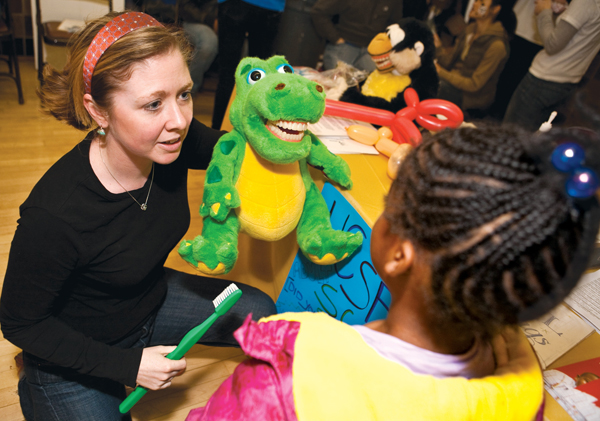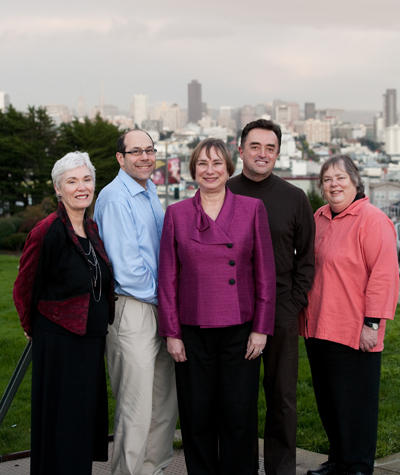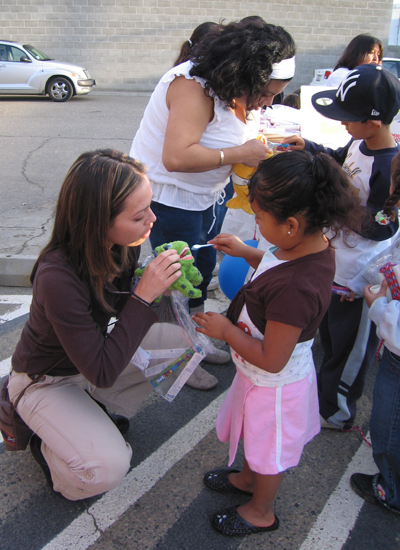Children's Oral Health Center Counters Early Childhood Caries Trend
 Kaitlin Jennison, a dental student in the Class of 2013, offers child friendly dental hygiene information during the Hayes Valley Fair at San Francisco's John Muir Elementary School.
Kaitlin Jennison, a dental student in the Class of 2013, offers child friendly dental hygiene information during the Hayes Valley Fair at San Francisco's John Muir Elementary School.Not true, unfortunately. Tooth decay among the youngest children is on the rise, according to the US Centers for Disease Control and Prevention. Poor and minority populations have been burdened disproportionately.
CDC data collected from 1999 to 2004 reveal that 42 percent of Mexican American and 32 percent of black children ages 2 to 5 have decayed or filled teeth, compared with 24 percent of white children. Limited access to dental care, lack of knowledge and even cultural norms in certain disadvantaged populations may contribute to these health disparities.
With an expanding network of colleagues in California and beyond, UCSF School of Dentistry researchers led by public health dentist Jane Weintraub, DDS, MPH, are guiding efforts to counter the trend through research and innovation. A major aim of the group, organized as the Center to Address Disparities in Children’s Oral Health (CAN DO), is to identify and evaluate additional preventive strategies and the best means for making these treatments available to the disadvantaged who need them the most.
Weintraub was recognized for her public health research and leadership by the American Dental Association with the prestigious Norton M. Ross Award for Excellence in Clinical Research in October 2010. Weintraub has contributed significantly to the reduction and prevention of oral health disparities, including early childhood caries. In fact, her research, which includes studies on the use of fluoride varnish on young children, has helped serve as the basis for scientific guidelines regarding fluoride and has become a part of mainstream dental and public health practices.
The first series of CAN DO projects demonstrated successful interventions to prevent and lessen the impact of tooth decay, and already has led to large-scale dental public health policy changes in California and across the country. The second round of studies has recently begun.
In fall 2009, the School of Dentistry received $24.4 million in new funding for CAN DO from the National Institute of Dental and Craniofacial Research (NIDCR), the largest grant in the school’s history. CAN DO began in 2001, and the new grant is projected to fund research through 2015.
CAN DO began with a few researchers and now includes dozens. “We’re not just dentists and oral health experts,” says Weintraub, the Lee Hysan Professor of Dental Public Health and Oral Epidemiology, an endowed chair in the dental school. “We have many kinds of expertise, and studies range from basic research to clinical and behavioral public health interventions. We’re trying to be a resource for the state – and for the whole country.”
Primary Teeth Are of Primary Importance
In the same way that being “just a baby” may excuse a tot’s inconvenient behaviors, soon to be outgrown, parents may think of primary teeth as “just baby teeth” – similarly transient and not worth worrying about. But nothing could be further from the truth. Although primary teeth are meant to be lost, it is still important to avoid making them a home for tooth decay. One reason is that young children afflicted with tooth decay in primary teeth are more likely to develop cavities in permanent teeth as they grow older.
“The biggest risk factor for future tooth decay is prior tooth decay,” Weintraub says.
It’s not sweets alone that cause cavities. The process of tooth decay, called caries, is driven by certain bacteria species that thrive on some of the carbohydrates in our diets, and we all know how food can stick to teeth. But not everyone knows that bacteria cause cavities, and even those who do may be unaware that the bacteria are infectious, spreading from parent to child or from child to child.
“An infection anywhere in the body is not good, and dental caries is an infection that has implications far beyond the mouth,” Weintraub says.
The disease can result in deterioration of not only teeth, but quality of life for both children and their parents, in many ways and for years to come. Advanced dental caries can lead to painful toothaches. Premature loss of primary teeth to decay can result in misaligned secondary teeth. Afflicted children may find it more difficult to eat, to concentrate and learn, to sleep, and to develop language skills. Self esteem may suffer.
“A toothache that is not treated is an infection that can spread,” Weintraub says. It can spread not only from person to person and from primary teeth to secondary teeth, but also beyond the mouth. In a case that made news headlines in 2007, a Maryland boy died because caries-causing bacteria from his untreated tooth decay caused an abscess that spread to his brain.
Parents may unknowingly spread infection. “Parents should not do some of the things they might be doing routinely, like cleaning a baby’s pacifier in their mouth and returning it to the baby’s mouth, or sharing eating utensils,” Weintraub says.
As soon as teeth erupt, usually by age 1, they are susceptible to dental caries, often called baby-bottle tooth decay. A sugary baby-bottle drink may help keep an infant calm and quiet for hours on end, but it also is a major contributor to tooth decay. Public health agencies now favor the term early childhood caries (ECC). ECC is by far the most common chronic disease condition of early childhood, five times more common than asthma, the runner-up.
Given how quickly ECC can take hold, it’s no surprise that the American Dental Association (ADA) recently shifted the recommended age for a child’s first dental exam to 1 year old instead of 3 years old. But many health care providers remain unaware of the revised recommendation, Weintraub says.
 Public Health Dentist Jane Weintraub, DDS, MPH, center, leads efforts to counter the trend of early childhood dental caries with UCSF researchers, from left, Margaret Walsh, Stuart Gansky, Francisco Ramos-Gomez and Judith Barker, a medical anthropologist, at the Center to Address Disparities in Children's Oral Health (CAN DO). Photo by Elisabeth Fall.
Public Health Dentist Jane Weintraub, DDS, MPH, center, leads efforts to counter the trend of early childhood dental caries with UCSF researchers, from left, Margaret Walsh, Stuart Gansky, Francisco Ramos-Gomez and Judith Barker, a medical anthropologist, at the Center to Address Disparities in Children's Oral Health (CAN DO). Photo by Elisabeth Fall.
Strengthening Enamel with Fluoride Varnish
Weintraub initially teamed up with fellow School of Dentistry faculty members Stuart Gansky, DrPH, a biostatistician, and Francisco Ramos-Gomez, DDS, MPH, a pediatric dentist who grew alarmed when he saw a steady stream of kids with cavities at the UCSF-run family dental clinic at San Francisco General Hospital (SFGH).
“Early childhood caries is preventable, and I felt strongly that we needed to do something about it,” Ramos-Gomez says. “We needed to move away from being reactive – to rely less on treatment and acute care and to move toward effective preventive strategies.”
Ramos-Gomez and Weintraub proposed counseling parents and using an inexpensive, easy-to-brush-on varnish containing a 5 percent sodium fluoride resin on their children’s teeth to strengthen tooth enamel. While the treatment was often used in Europe and had been tested on older children with permanent teeth, its value had not been established for protecting primary teeth, Ramos-Gomez recounts.
Weintraub, Ramos-Gomez and Gansky conducted their groundbreaking study on primary teeth in 376 children averaging just under 2 years old when first enrolled in the study. The children, seen at SFGH and at the San Francisco Department of Public Health’s Chinatown Health Center, were mostly low-income, and Chinese or Hispanic. Parents were counseled on preventing tooth decay and children were randomly assigned to receive fluoride varnish once or twice a year, or not at all.
With two years of follow-up, the result was clear. Children randomly assigned to receive varnish twice yearly were nearly four times less likely to develop tooth decay compared with untreated children, and children who received varnish once yearly were half as likely to develop tooth decay as untreated children.
The published results had great impact. For children up to age 6, the California Medicaid program began to cover fluoride varnish application – reimbursing not only dentists, but also physicians as well as trained personnel in their medical practices. Nationally, the ADA now recommends the varnish for the youngest children at high risk of developing ECC.
Why the Poor Are Prone to Cavities
During the first phase of CAN DO, researchers also began exploring why disadvantaged kids were so prone to cavities.
Judith C. Barker, PhD, a medical anthropologist in the UCSF School of Medicine and CAN DO associate director, led an ethnographic study in a rural, largely Hispanic farm town in California’s Central Valley, and in an ethnically similar, low-income neighborhood in urban San Jose. One of the researchers lived in the farm town for nine months, establishing relationships in the community.
The researchers hired local residents as interviewers and sometimes even provided transportation to clinics. Mothers were more accessible, as fathers often were at work. Study results point to a need for better oral health education, for better prevention practices and for better access to care, Barker says.
“We found that a majority of mothers had a poor understanding of the mechanisms that drive caries, and a poor understanding of when they should be taking their children to the dentist,” Barker says. “Many parents would not visit a dentist until a child was 3 or 4 years old, and often not until a child’s teeth were extensively damaged and the child complained of pain. The mothers generally do not recognize early signs of caries in children.”
Parents were shocked to learn that what they thought were dark stains that could be cleaned away by the dentist were in fact cavities.
As with childhood obesity, sugary drinks play an insidious role, but often seem to fly in under the radar. Barker recounts an interviewer’s tale of a mother and grandmother of a cavity-afflicted 3-year-old discussing at length their rationing of candy and cookies, even as the child was walking around the entire time drinking from a bottle of chocolate milk.
“Neither the mother nor the grandmother understood how much sugar was in the milk,” Barker says. Children often are put to bed with a bottle of juice. Toothbrushing was rarely supervised after age 3, and some parents did not believe brushing was merited until the child had all of his or her primary teeth or was eating an adult diet.
Similarly, Susan Hyde, DDS, MPH, PhD, from the School of Dentistry, and Sally Adams, RN, PhD, from the School of Medicine, explored attitudes toward caries prevention practices among mothers of young children in urban minority populations. Mothers generally were highly accepting not only of toothbrushing, but also of fluoride varnish.
In the rural area, dentists were few and far between; the closest pediatric dentists were in Fresno, about 50 miles away. Furthermore, dentists in both rural and urban areas often were unwilling to treat children less than 6 years old, largely because they had never rotated through a pediatrics clinic during their training, and they felt unprepared as a consequence.
Moreover, many dentists did not accept Medicaid (Denti-Cal) payment. Those who did had long waiting lists. Children from low-income families often waited months for screening or treatment.
Even where municipal water supplies were fluoridated, most Hispanic residents in the study preferred to drink bottled water, believing it to be safer than tap water. Bottled water usually does not contain fluoride, a recognized cavity fighter.
 Children get a hands-on lesson in oral health from UCSF students.
Children get a hands-on lesson in oral health from UCSF students.
Cavity Prevention: Community Ties Are Vital
Like Barker, Ramos-Gomez knows the importance of engaging the community for the success of local research and health initiatives. Ramos-Gomez is currently on the faculty at UCLA, but remains a CAN DO project leader. For more than a decade, researchers have nurtured community connections via the San Ysidro Health Center near the California-Mexico border. An understanding of and sensitivity toward family traditions and community social structures are crucial, Ramos-Gomez says, as is an active community advisory board.
“Community-based participatory research is not business as usual,” Ramos-Gomez says. “You really have to establish links and relate to the community. We felt strongly that we had to start by engaging pregnant women.”
In a prior CAN DO caries prevention clinical trial, he and his research team recruited bilingual, culturally competent promotoras. Promotoras are women from the community who serve as health communicators, linking the community to researchers and health care providers.
“You need to have the personal touch, and these women really connected,” Ramos-Gomez says. There were few dropouts. “For a border population, the high retention rate in the study [almost 70 percent] is unheard of,” he says.
CAN DO Begins Round Two
School of Dentistry researcher Lisa Chung, DDS, MPH, also believes in the importance of reaching out early to pregnant women. Chung is project director for a new, two-year Bay Area study led by Adams. The researchers are developing and testing an intervention aimed at promoting oral health by changing behaviors. The intervention is being integrated into the CenteringPregnancy® curriculum, a group prenatal care model.
“Pregnancy is an opportune time for health messages because women are more receptive to behavior change,” Chung says. “We hope that the women will see a dentist and become more inclined to bring their babies to see a dentist.” As it stands, only a small fraction of low-income women see a dentist during pregnancy.
For the most recent round of CAN DO studies, the research team is updating its clinical trials management system software, says Gansky, who heads the Data Coordinating Center. The new software will initially be used to manage six randomized, controlled clinical trials. These include not only NIDCR-funded CAN DO trials, but also studies led by Centers for Research to Reduce Disparities in Oral Health at Boston University and the University of Colorado Denver.
A large clinical trial in the second round of CAN DO builds on the success of the initial fluoride varnish clinical trial. Led by Ramos-Gomez, half of participating children ages 3 to 6 will be given not only twice-yearly fluoride varnish, but also an additional preventive treatment – a new kind of fluoride-containing sealant that will protect the biting surfaces of primary molars. Called a glass ionomer, the sealant is much easier to apply than earlier generations of sealants and releases fluoride.
Treatment will be provided by dental and other health care providers at the San Ysidro Health Center, as in the earlier study, and at Comprehensive Health Center Ocean View, also in San Diego County.
School of Dentistry researcher Margaret Walsh, EdD, also has been examining the role of other health care providers in preventing early childhood dental disease, and has explored family acceptance of different ways of providing education about caries prevention, including automated telephone counseling.
Walsh and her research group have worked with physicians and nurses in primary care clinics – and with dental hygienists in alternative practice – at sites that provide food through the Women, Infants, and Children (WIC) program. The goal is to identify the most effective means of disseminating fluoride varnish treatment to high-risk children ages 1 to 3 to prevent caries in both dental and nontraditional care settings.
When prevention is neglected, tooth decay in infants can become a heavy burden, Weintraub emphasizes.
“You can’t get a 1-year-old to sit still in a dental chair,” Weintraub says. “Often when they need dental care, they have to be treated using general anesthesia in a hospital. That makes it expensive and traumatic for the family, and often those services are not even locally available.”
“We want to give parents and health care providers tools to improve the oral health of children,” Weintraub adds. “Dentists can’t do it all by themselves; there aren’t enough of them to treat all the tooth decay that’s out there.”
While the current budget picture for dental public health programs may appear daunting, that’s nothing new to Weintraub, who launched her career during another recession in the early 1980s. At such times, she says, “The need for preventive measures does not diminish; it becomes greater.”